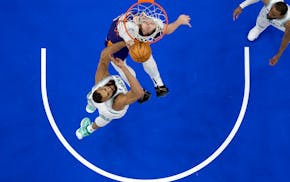At times, when Gophers guard Malik Smith plants his feet and lifts the ball above his head to shoot, coach Richard Pitino sees something else.
His mind jumps to the baseball diamond; to home plate, where the late-game hope is digging in his cleats and eyeing the fences. However many times he has whiffed before doesn't matter. Not now.
With so much in transition for the 6-2 Smith after transferring from Florida International to Minnesota, where his role has shrunk dramatically, one thing hasn't changed: When the game is in the balance, when the seconds are ticking away above the court — he lives for those moments.
"Malik is the type of guy — he's a home run hitter who wants to be up in the bottom of the ninth," Pitino said. "He may not be the best fielder, he may not be the best baserunner. But you've got confidence when he's going to shoot the ball that it's going in. He's just one of those guys that you want on the court. There is something unique about a kid who wants to shoot that shot. Not everybody does that. Some people hide from it. He does not hide from it."
No doubt, Smith's shot selection can be frustrating. Already in the Gophers' short season, the senior has attempted a barrage of questionable shots, throwing up balls when heavily guarded and with hands in his face. By the same accord, though, he's also proven capable of hitting the big shot.
In Tuesday's game against Coastal Carolina, Smith hit a pair of three-pointers early to boost the Gophers to a quick lead, one they would struggle to keep. On Saturday at Richmond, Smith hit a pivotal three-pointer with 3 minutes, 40 seconds to go that pushed the Gophers advantage from two to five and got the Spiders scrambling.
Moments like that one are what Pitino became accustomed to last season at Florida International, when Smith set an FIU record for three-pointers in a season with 96.
"I'm definitely more aggressive in those situations than any other situation," Smith said of taking the "big" shot. "Some people are worried about whether they're going to miss. I'm just thinking the ball is going in every time."
Of course, it doesn't. So far this season, Smith is connecting on 32 percent of his three-point attempts, but he's shot 25, more than anyone on the team except for Andre Hollins, who is averaging over 15 more points. Conceivably, Smith's make rate could be significantly higher if he were a little discriminating in choosing his moments.
"He's the type of guy, he'll shoot some shots that will drive you crazy, it drives me crazy," Pitino said. "But then he hit a three with just [over] three minutes to go that essentially won us the game. So as a coach, you kind of have to deal with it a little bit, and you've got to give him a little bit of a longer leash than some other guys."
That's fine with the coach, as long as Smith works to improve the rest of his game. Smith has only attempted four shots that weren't three-pointers (making one), and hasn't shown the same discipline as other players on defense, on the boards or in the little things such as chasing down loose balls.
Part of that is Smith simply getting adjusted to life as one of many guards, rather than being the star shooter. A year ago, the Boston native could hang out on the perimeter a little more, waiting to get the ball. This year, his mind-set has to change as he tries to aggressively pursue good shots while also funneling the ball to the new star scorer, Andre Hollins.
"Now I have to pick my spots," Smith said. "Last year I pretty much had the green light for me to go whenever I felt like it. It was pretty hard for me to figure that out through the first two games, when to be aggressive and when not to, but I think I'm starting to feel more comfortable now."
Swinging for the fences will bring some strikeouts. But when the ball is sailing high above the wall, well, those strikeouts are forgotten.

Souhan: Wolves fans made Game 1 special. Now bring on Game 2.

Will Wolves show best-in-the-NBA defensive form in Game 2?
NFL draft has been on tour for a decade and the next stop is Detroit, giving it a shot in spotlight

Former Totino-Grace star set to follow father as first-round pick
